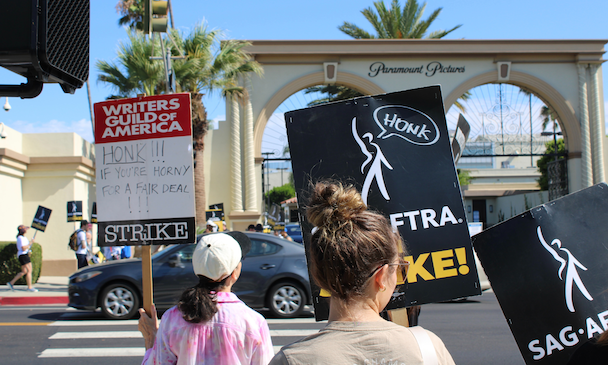Hollywood’s nearly 5-month strike could be coming to an end. What’s next for advertisers?
Industry insiders say the landscape of entertainment has changed for good. Can advertisers adapt?

Screenwriters have reached a tentative agreement with Hollywood's production studios and networks / Chris Long
The Writers Guild of America (WGA), representing over 11,000 screenwriters, has reached a tentative agreement with Hollywood’s networks and entertainment companies – a development likely to end the union’s historic 146-day strike. The deal is expected to get members’ stamp of approval in an upcoming vote.
Despite the development, Hollywood’s actors are still striking – leaders of the Sag-Aftra union have not met formally with studio execs in over two months. The complete resurgence of the television and film industries relies on the two sides’ ability to come together on an agreement.
In lieu of scripted programming, TV networks and streaming platforms have had to rely this summer on live events, sports, reality TV and reruns. And it would appear that viewers haven’t been too dissatisfied: the 2011-2019 drama Suits has been the most-steamed title for two and a half months straight, according to new data from Nielsen. Plus, adds LG Ad Solutions chief marketer Tony Marlow: “People have also been diving into the vast back catalog of on-demand streaming content and international content available on both subscription and free ad-supported TV services.”
Advertisement
User-generated content also ate up a greater slice of the pie in the absence of new film and TV entertainment – TikTok surpassed 1.7 billion users this year, representing a 17% increase from 2022. The shift forced advertisers to reconsider their ad budgets, and late spring and early summer upfronts were marked by a degree of hesitancy on the part of media buyers.
Now, the clock is ticking on Sag-Aftra and the entertainment companies, represented by The Alliance of Motion Picture and Television Producers (AMPTP), to reach a deal. Without one, the industry remains suspended – and advertising dollars hang in the balance.
“The studios need to navigate negotiations with Sag-Aftra – which represents tens of thousands of actors – each with their own set of demands and negotiations. This may extend the overall labor unrest in the industry,” says Hunter Terry, general manager of connected television (CTV) at data solutions provider Lotame.
Advertisement
Still, Terry says, it’s important to acknowledge how the WGA and Sag-Aftra strikes have already changed the TV and film industries – and the advertising ecosystem that supports them. “Advertisers have had to adapt their strategies in response to these changes [in programming, consumption and ad spending habits], and while there may have been shifts in ad buying approaches, spending on TV advertising is expected to remain robust.” Streamed video and CTV, particularly, he suggests “stands out as a dominant channel for digital ad buying, continuously attracting a growing share of ad dollars.”
In short, he says, “As long as there are audiences watching TV, advertisers will find innovative ways to connect with them and invest in advertising opportunities.”
The sentiment that CTV is in an especially strong place for advertisers today is underscored by recent Nielsen viewership data, which finds that, for the first time, cable and broadcast TV represent less than half of all usage among US consumers. Cable viewership is down 12.5% since last year, while broadcast has dropped 5.4% in the same period. Meanwhile, streaming and connected TV continue to rise.
Suggested newsletters for you
“This dynamic period is a chance for companies focused on measuring performance in the CTV space to help brands find their way through the changing advertising scene and keep strong connections with viewers amid industry ebbs and flows,” says Jeremy Haft, chief revenue officer at performance marketing firm Digital Remedy.
Other industry leaders echo Haft’s sense that the moment is ripe for innovation. “This agreement comes at a pivotal time for the studios and their streaming platforms, as many of the large legacy media companies are still dealing with challenges in streaming business models, investing in creating valuable content, managing consistent consumer churn [and attempting to navigate] audience fragmentation and significant technology investments,” says Dave Helmreich, chief commercial officer at advertising analytics platform Innovid.
He implies that mounting pressure on AMPTP may motivate major studios, networks and platforms to invest in new solutions that better serve consumers and advertisers. Media measurement across different screens and channels and subscription models in light of high churn and viewership frayed across different offerings are of particular concern.
The agreement between WGA and AMPTP could accelerate such positive changes and “be a win from all sides if successfully finalized,” LG Ad Solutions’ Marlow says.
Of course, it’s not over until it’s over. WGA members are yet to vote on the agreement, and logistical steps will be required to finalize the deal before it goes into action. Meanwhile, Sag-Aftra and AMPTP have no forthcoming talks scheduled, leaving Hollywood at a production impasse.
Ad industry execs advise that brands and media agencies should proceed cautiously for the time being. “The advertising industry is known for adjusting to changes – however, this recent development adds a nuanced layer to the broader narrative. We anticipate a cautious optimism as advertisers closely observe the situation, particularly the ongoing Sag-Aftra strike, before recalibrating their strategies,” says Digital Remedy’s Haft.
If one thing is clear, it’s that the strikes have forced both entertainment giants and their ad ecosystems to adapt. In doing so, new challenges and opportunities have arisen for advertisers to shine in the next era of entertainment. “The entertainment landscape has evolved, and those in the advertising world will need to adapt and capitalize on these changes to continue reaching audiences effectively,” says Lotame’s Terry. “The [potential] end of the strike marks a new chapter for the industry, and it will be fascinating to observe how these developments unfold in the post-strike era.”
For more, sign up for The Drum’s daily newsletter here.
